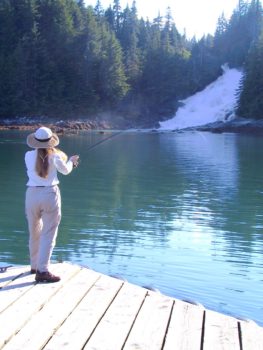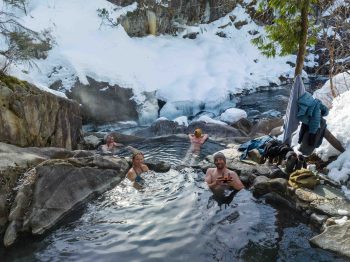What to Bring
Weather
For most of the year, expect daytime temperatures between 50 and 70 degrees (F). Having said that, wind chill can make these temperatures feel significantly cooler, especially when underway or out in the skiffs. Visits to glaciers can also mean cooler temperatures and brisk winds. Weather patterns can shift rapidly, and both rainy days and bright, sunny days are likely in a given week.
Clothing
Staying warm, dry and comfortable will allow you to get the most out of your experience. Casual clothing is sufficient, both on the boat and around town. Because weather conditions can vary widely, layering for warmth is the best approach. For windy and/or rainy conditions, we strongly recommend a waterproof (not water resistant) windbreaker and rain pants.
Please remember that you will be living on a boat. The cabins have a closet and drawers, but storage is still limited. Duffel bags (or other soft-sided luggage) will be easier to stow, allowing for more space in your stateroom.
- Pants (jeans or hiking pants)
- Shorts (especially in summer)
- Shirts (long & short sleeved, suitable for layering)
- Sweaters (wool or synthetic fleece is best)
- Sweatpants or other comfortable pants
- Rain jacket or waterproof windbreaker (preferably with hood)
- Rain pants (optional, but useful)
- Long underwear
- Gloves (lightweight wool or synthetic is best)
- Bathing suit (for hot springs)
- Hat (for warmth, wool or synthetic)
- Visor, ball cap, or broad-rimmed hat
- Shoes
- Soft comfortable shoes with non-marking soles for wear around the boat
- Knee-high rubber boots for beach landings and tide pooling (inexpensive boots are available around town, and we also have limited sizes on the boat)
- Light hiking boots or shoes (optional, but useful)
When packing your gear for the trip to Alaska, please make sure that boots, outerwear, packs, etc are sanitized of any possible hitchhikers such as insects and seeds. Southeast Alaska is a special place with a delicate natural balance and we would like to make sure that we do our part to avoid possibly introducing invasive species that could pose a threat to this fragile environment.
- Please clean out and wash off the treads of your shoes and boots
- Clean or vacuum out your jacket pockets and pack compartments
Equipment and Other Items
- Binoculars Sunglasses
Sunblock & SPF lip balm - Camera gear
- Laptop or backup image storage
- Soft day pack
- Flashlight
- Personal toiletries
Camera and Video Equipment
Photographic opportunities abound aboard the Northern Song, and the right equipment can help you make the most of them. While a point-and-shoot camera (and even a mobile phone!) will allow you to capture some great shots, an SLR camera body is your best bet. Whichever option you choose, make sure to bring more batteries and memory cards than you think you’ll need!
Because wildlife subjects will vary from the very large (whales) to the very small (tide pool critters), and from near to far, a zoom lens or range of lenses is often best. For those interested in bird photography, a long lens (400mm or longer) will provide the best opportunity. Landscape photography is generally best done with a wide-angle lens, allowing you to capture dramatic expanses of sky and water.
Video cameras are also a great option, especially given the array of inexpensive models now on the market. Go Pro cameras (or similar) are lightweight and waterproof, and capable of capturing some great footage (they are also easy to drop, so consider a buoyant attachment!).
![]() PDF of the Packing ListSince most photography occurs from on board the yacht (and is often handheld), we suggest utilizing image stabilizing lenses whenever possible. Monopods or tripods may also be useful, especially for land-based photography.
PDF of the Packing ListSince most photography occurs from on board the yacht (and is often handheld), we suggest utilizing image stabilizing lenses whenever possible. Monopods or tripods may also be useful, especially for land-based photography.
Polarizing filters for photography around and over the water are highly recommended. A UV filter may be useful in protecting your lens from salt spray.
When traveling in the skiff we will be close to the water. Even on a sunny day in calm water, there is an “invisible” salt mist in the air. This is hard on camera equipment. Make sure to bring some kind of protective bag or case for your equipment, or at least some heavy plastic bags. Rubbing alcohol works great to remove salt spray from camera bodies. Lens cleaning fluid and a chamois cloth are best for cleaning lenses.
The Northern Song is equipped with 110V outlets in each cabin, and in several locations throughout the salon and bridge. These outlets are available 24 hours per day for battery and laptop charging.
“The trip just got better and better every day! It far exceeded my expectations and I find myself renewed in spirit and in body.
Thank you-Thank you- Thank you”
Tom U.
Los Angeles, CA



